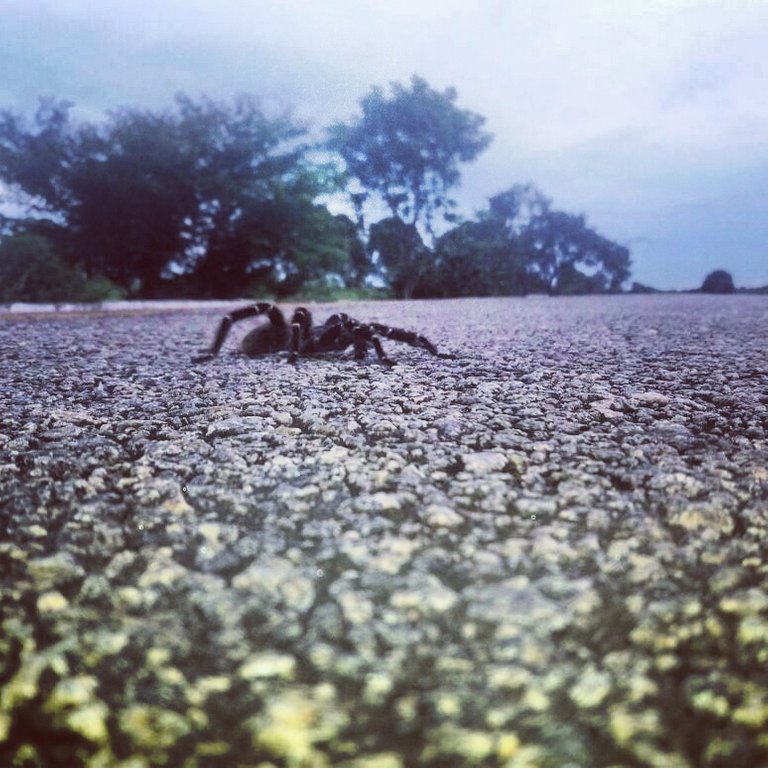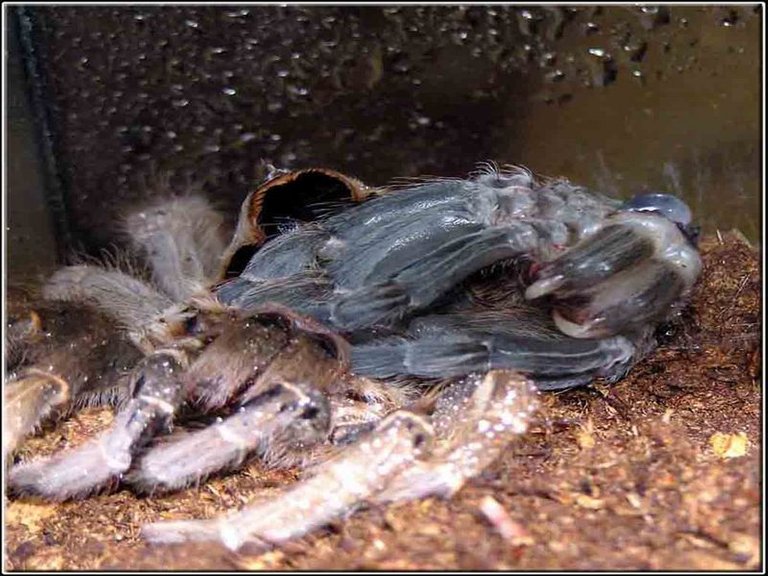
Photographer: @bruh.day link: https://www.instagram.com/p/Bd_pCjADxCl/?taken-by=bruh.day
Phylum: Arthropoda
Class: Arachnida
Order: Arnfeae
Family: Theraphosidae
It is a spider that scares many people because of its large size and hairy body.
The tarantulas are harmless to humans (their bite is quite sore), and their venom is weaker than the common bee sting.
There are people who even have a tarantula as a pet. Already other people have phobia of this animal. (Arachnophobia)
There are hundreds of species of tarantula found in most of the tropical world, subtropical and arid regions.

Tarantulas periodically make the molt, releasing their exoskeleton.
In the process of molting, they also replace internal organs such as the female genitalia and stomach, and even regenerate lost appendages
They vary in color and behavior according to their specific environments.
But the vast majority of tarantulas live in burrows, on the ground.
The caranguejeira is endowed with six or eight eyes, according to the family.
Tarantulas move slowly during the day, but are excellent nocturnal predators.
Insects are their main food, but they can also eat frogs, frogs, rats and even small birds.
The venom injected into the prey facilitates the digestion of the spider because it contains enzymes that break down proteins.
She injects the poison, and can stay up to two full days sucking the liquid part of the bodies of her victims.
The tarantula's poison effect is much more potent in cold blooded animals (such as reptiles).
Tarantulas can live up to 35 years and grow up to approximately 30 centimeters.
Caranguejeiras (or tarantulas) are distinguished by having four lungs and stinging chelicerae with vertical movement.
The two venomous glands are located integrally at the base of the chelicerae.
The other spiders, which have two lungs or none, have stings that articulate horizontally (from the outside in).
Tarantulas have few natural enemies, such as wasps.
A wasp can paralyze a tarantula with its sting and place its eggs on the spider's body. When eggs hatch, the wasp larvae feed on the tarantula still alive
..jpg)
The tarantula mating ritual begins when the male weaves a web and deposits sperm on its surface.
He copulates using his pedipalpos (short, appendix located near the mouth) and then runs away.
Sometimes females eat their mates.
In many species of spider, the female is much larger than the male and can easily devour it.
For this reason the male who wants to mate is approached as carefully as possible.
The male can frantically sway the paws or palps (sensors located on the head), or can walk carefully through the female's web taking steps as if dancing, to distinguish itself from other insects.
Sometimes he can approach and offer an insect as an appetizer to distract him.
The tarantulas do not see well, so they communicate by touch. When a male encounters a female, he manifests his presence by using the front paws to play, with rhythmic movements, on her body. She gets scared and lifts her front paws, ready to attack. It takes a lot of effort and caress from the male to calm her down.
Finally, she raises her body and opens the deadly prey capable of annihilating him with a single bite. But he is not unprepared. The male has hooks on the special front legs to separate the jaws from the female. At last saved, he inseminates the female and then withdraws as quickly as possible.
The mating of two tarantulas takes about one minute.
Tarantulas have a long life cycle and take from 2 to 5 years to reach sexual maturity.
Crabs lay from one hundred to three hundred eggs at a time, but few pups survive. The burrows are usually subterranean, dug by their jaws, or even harnessed from other spiders or rodents.
They are lined with their web forming a silk, which cools the hiding place.
They are usually close to tree roots and stones, and can reach up to 1 meter deep. The tarantula does not use web to catch prey, although it can use a signaling web as an alert that something is approaching its hiding place.
These spiders grab their claws, inject paralyzing venom into their victims with their fangs.
They also secrete digestive enzymes to liquefy the bodies of their victims so they can suck them. After a large meal, the tarantula can run out of food for a month.
The tarantula web serves as an alarm against unwanted visits. In addition to the normal "hairs" that cover the body of the tarantulas, some also have a dense covering of irritating hairs, called stinging hairs, which they sometimes use as protection against enemies.
These fine hairs are barbed and designed to irritate.
They can be lethal to small animals like rodents.
Some people are extremely sensitive to these hairs, and develop serious infections and eruptions on the spot.
Contact of the hairs with the eyes and respiratory system should be strictly avoided.
Species with stinging hairs can loosen hairs by shaking the hind legs in the air. Stuttering hairs do not grow back but are replaced at each molt.
tarantula
Tarantulas also use these hairs for other purposes, such as marking territory and the entrance of their nests
The intensity, quantity and fluctuation of the hairs depends on the Tarantula species.
For predators and other types of enemies, these hairs can range in being lethal or simply being a deterrent.
Muito bom
AI to look for newbies who write good content!
 Hi. I am @greetbot - a bot that uses
Hi. I am @greetbot - a bot that uses
Your post was approved by me. As reward it will be resteemed by a resteeming service.
Curious?
introduction post
Check out the great posts I already resteemed.Resteemed by @resteembot! Good Luck! The resteem was paid by @greetbot The @resteembot's Get more from @resteembot with the #resteembotsentme initiative
Congratulations @bangbug! You received a personal award!
Click here to view your Board
Do not miss the last post from @steemitboard:
Congratulations @bangbug! You received a personal award!
You can view your badges on your Steem Board and compare to others on the Steem Ranking
Vote for @Steemitboard as a witness to get one more award and increased upvotes!